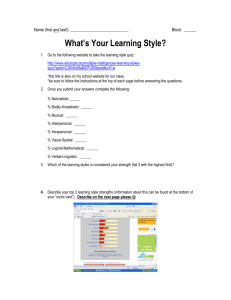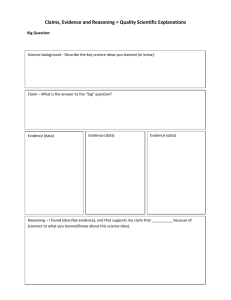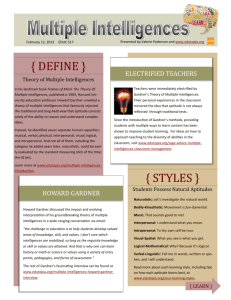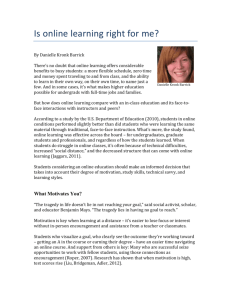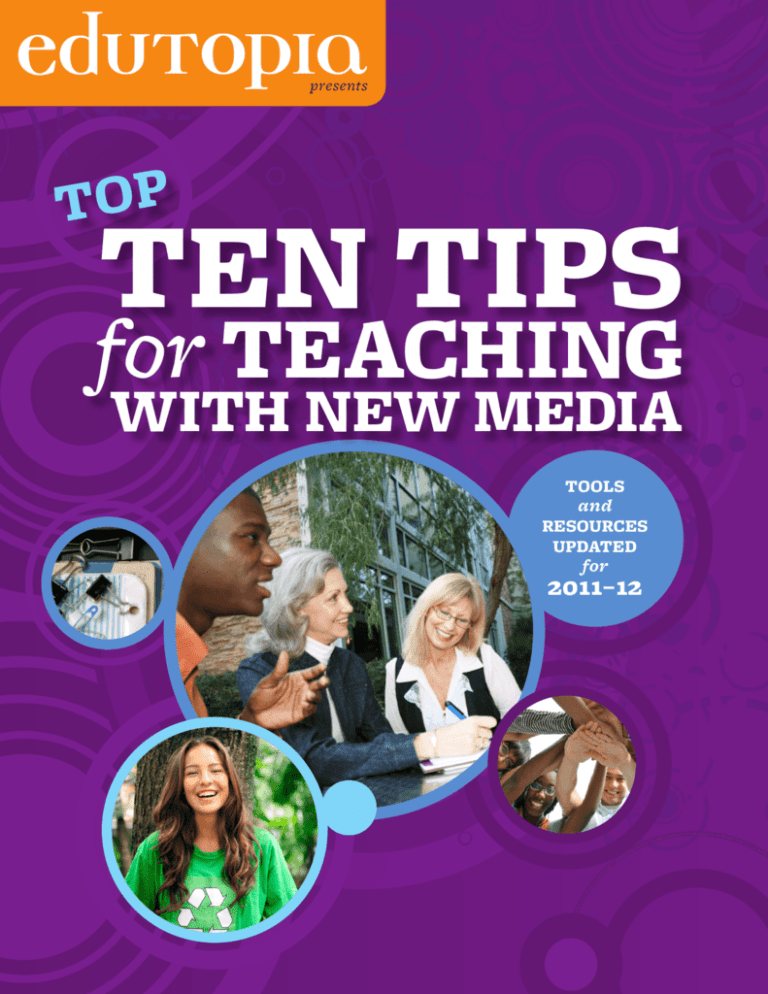
presents
TOP
TEN TIPS
for TEACHING
WITH NEW MEDIA
TOOLS
and
RESOURCES
UPDATED
for
2011–12
1
Top Ten Tips
for Teaching with New Media
WHETHER YOU’RE BRAND-NEW to the profession or a classroom
veteran, we hope you’ll discover some fresh ideas in this collection of tips
and resources on how to bring new media into the classroom. Easy-touse tools will help you build your classroom community, survey students
to bring out their ideas, and make learning more collaborative. You’ll find
links to resources for incorporating everything from infographics to citizen
science projects too.
Students of all ages will benefit from building a strong classroom culture
(Tip #1: Break the Digital Ice). If you teach at the elementary level, you
might want to introduce tools that pack a lot of visual interest, such as
VoiceThread or Glogster (Tip #9: Put Your Best Face Forward). Older
students are likely to enjoy using social-media tools like Edmodo or Twitter
(Tip #8: Make Learning Social). Even texting deserves a spot in your tech
tool kit, if you harness it for a good cause (Tip #2: Survey Your Experts).
And at all ages, kids will benefit from the chance to make a difference
(Tip #3: Get Off to a Good Start).
We’d love to know how you put these ideas to work. Please join the ongoing
conversation in the Edutopia community and connect with others who
share your passion for improving education.
TIP LIST
1.
Break the Digital Ice
2. Survey Your Experts
3. Get Off to a Good Start
4. Contribute to Science
5. Find What You Need
6. Make Meaning
with Infographics
7. Work Better, Together
8. Make Learning Social
9. Put Your Best
— Suzie Boss
Edutopia.org blogger and author of
Reinventing Project-Based Learning
visit edutopia.org
Face Forward
10.
Use the Buddy System
tip #1
Break the
Digital Ice
ICEBREAKERS ARE a time-honored tradition
for starting the new school year. Scavenger hunts,
name games, and other introductory activities
help teachers and students get acquainted so they
can start building a positive learning community.
Give this important classroom tradition a makeover
by integrating digital tools. Try a low-tech activity,
as well, to build teamwork and unleash creativity
right from the start.
Wallwisher (http://wallwisher.com) is an easy-to-use tool for brainstorming and gathering feedback. Once you set up a free account, you can
quickly create a virtual wall. Name your wall and use the subhead field to add
a prompt: What’s the best book you read this summer? What’s your number
one goal for this school year? If you could take a field trip anywhere, where
in the world would you choose? Note the URL for your page, and then send
students to your wall. With a click, they’ll create a new “sticky note” where
they can post their response. Even students who may be reluctant to speak
up during the first days of school will have a voice in this conversation.
AnswerGarden (http://answergarden.ch) is another online tool for
gathering student responses in a flash, and you don't need to register to
use it. To get started, just enter your question and click “Create an AnswerGarden.” You can embed your AnswerGarden on a blog, website, or social
network, or you can give students a link for posting their replies. The site
displays their answers in a word cloud.
VoiceThread (http://voicethread.com) can help you and your students get better acquainted. The site allows users to combine photographs
or other visuals with written or audio comments. You might introduce
VoiceThread as a whole-class activity using a projector or interactive
whiteboard. Share a digital album to introduce yourself, then invite students
to record their own audio comments to help you learn more about them—
and to help them learn about one another.
If you’re planning projects that will involve teamwork, here’s a lowtech, low-risk activity to build collaboration skills early in the year. The
Marshmallow Challenge (http://marshmallowchallenge.com) asks teams to
use 20 sticks of dry spaghetti, a yard of tape, a yard of string, and a marshmallow
to build the tallest freestanding structure they can devise that will support
the weight of one marshmallow. Learn more about the power of this simple
challenge by watching this TED Talk by innovation expert Tom Wujec:
http://ted.com/talks/lang/eng/tom_wujec_build_a_tower.html.
3
TOP TEN TIPS FOR TEACHING WITH NEW MEDIA
Related Resources:
➔Educator and ed-tech guru Tom
Barrett has created a slide show
called “Interesting Ways to Use
Wallwisher in the Classroom”
as part of his Interesting Ways
series: http://edte.ch/blog/
interesting-ways/.
➔“100 Ways to Use VoiceThread in
Education” is a teacher-created
VoiceThread about VoiceThread:
http://voicethread.com/#q.
b26224.i145977.
➔You can explore this Edutopia
article, “VoiceThread Extends
the Classroom with Interactive
Multimedia Albums”:
http://edutopia.org/
voicethread-interactivemultimedia-albums.
➔Read this Edutopia blog post,
“Marshmallows, Innovation,
and Good Talk at ISTE,”
which is about bringing the
Marshmallow Challenge to
school: http://edutopia.org/
blog/iste-innovationmarshmallow-challenge.
EDUTOPIA.ORG
tip #2
Survey Your Experts
MANY OF TODAY’S DIGITAL KIDS spend their free time producing
videos, posting on social-networking sites, and text-messaging their friends.
You can take advantage of their technical know-how in the classroom
too. Locate your classroom experts with a survey that asks who has experience
with graphic design, digital photography, podcasting, video editing, blogging,
animation, or any other tech skills you may want to tap.
Poll Everywhere (http://polleverywhere.com) offers free surveys for up
to 30 participants. They can respond via texting, cell phone, Twitter, or the
Web, and responses appear instantly. Polldaddy (http://polldaddy.com)
is another service that’s free for up to 100 survey responses per month, and
it even has an app for the iPad.
You can also embed a Google form on your class website or blog to collect
survey responses. Once you have gathered raw data, save your information
as a spreadsheet so that you can easily identify your classroom experts
when the need for specialized help arises. Or better yet, ask your resident
spreadsheet experts to help you. Learn more about Google for Educators
in “Google for Educators: The Best Features for Busy Teachers”: http://
edutopia.org/google-educators.
Cast a wider net for technical expertise by surveying parents. Even better,
have your students survey their family members. Don’t overlook other experts
in your school community. After-school technology clubs, instructionaltechnology staff, school-media specialists, and other tech-savvy colleagues
are all likely sources of expertise.
4
TOP TEN TIPS FOR TEACHING WITH NEW MEDIA
Related Resources:
➔Other online survey tools include
ProfilerPRO (http://profilerpro.
com), SurveyMonkey (http://survey
monkey.com), and Zoomerang
(http://zoomerang.com). Many
online survey tools offer free
basic accounts.
➔Marie Bjerede, posting on the
O’Reilly Radar blog, explores the
use of mobile devices for classroom
polling and other instructional uses:
http://radar.oreilly.com/2010/03/
cell-phones-in-classrooms.html.
➔What do administrators think
about using cell phones in class?
Join the ongoing discussion about
this topic in the Edutopia community: http://edutopia.org/groups/
administrators/26013.
➔“Teens, Cell Phones, and Texting,” a
report from the Pew Research Center,
shares the latest data about teens and
their use of mobile devices: http://
pewresearch.org/pubs/1572/teenscell-phones-text-messages.
EDUTOPIA.ORG
tip #3
Get Off to a
Good Start
GET THE SCHOOL year off to a good
start by adopting a new tradition that will
benefit your students and build a sense
of community.
Morning meetings help set a positive
tone for the whole school day. Learn more
about this community-building tradition
in the Edutopia video, “Community
Begins with the Morning Meeting”: http://
www.edutopia.org /louisville-selmorning-meetings-video. Then, find
ideas for how you can introduce positive
social and emotional learning strategies—
whether you’re ready to invest five minutes,
five days, or five years—in the companion article, “Set Up Social and
Emotional Learning in Your Classroom, School, or School District”: http://
www.edutopia.org/louisville-sel-replication-tips.
A daily tradition called Gathering creates a supportive environment at
an alternative school where students are getting a fresh start. Learn more
in this blog post, “The Art of Building School Community”: http://www.
edutopia.org/building-school-community-eagle-rock.
Getting students involved in school-wide service projects is another
strategy for building a positive environment. Edutopia blogger Heather
Wolpert-Gawron describes a project she planned to use to launch the new
school year at her not-so-green middle school in her post “PBL: Picking
a Start-of- the-Year Project”: http://www.edutopia.org/blog/projectbased-learning-example-save-tree. She wisely focuses on a local issue
that her students are apt to care about.
For more ideas about building community by doing good things, read
about how students in a rural school protect trout habitat near their campus
and use math to design and build kid-sized garden benches in the Edutopia
article “Rural Students Reap Academic Gains from Community Service”:
http://www.edutopia.org/service-learning-fowler. Or watch “Wetland
Watchers: Kids Care for Their Environment,” a video about Louisiana
middle school students who have become acclaimed wetlands monitors:
http://www.edutopia.org/wetland-watchers-service-learning-video.
5
TOP TEN TIPS FOR TEACHING WITH NEW MEDIA
Related Resources:
➔Document and publicize students’
good work with photo-sharing sites
such as Flickr (http://www.flickr.
com) and Picasa (http://www.
picasa.google.com).
➔Learn more about social and
emotional learning, and get
downloadable resources and
articles for parents, from this
Schools That Work series:
http://www.edutopia.org/
stw-jefferson.
➔Learn more about service-learning
strategies at Lift: Raising the
Bar for Service-Learning Practice
(http://lift.nylc.org), a site
from the National Youth Leadership Council.
EDUTOPIA.ORG
tip #4
Contribute to Science
IN CITIZEN SCIENCE PROJECTS, people of all ages team up with
professional scientists to gather needed research data. By involving your
students in citizen science projects, you’ll help them gain a deeper understanding of scientific inquiry. And because these are authentic projects, you
can be sure students will never ask, “When will we ever need to know this?”
One of the best places to connect with citizen science projects is the
Cornell Lab of Ornithology (http://birds.cornell.edu). You and your students
can join projects that involve investigating everything from bird migrations
to global climate change. This year, scientists need data about those birds you
see in areas such as your own backyard (the types and number) to help them
track bird populations on private grounds across North America.
You can get started contributing your own real-time data at eBird (http://
ebird.org). It’s also a gold mine of interactive maps, charts, and other up-todate data outputs. (Click on the “View and Explore Data” tab to see more.)
Through its Project NestWatch website (http://nestwatch.org), the
Cornell Lab of Ornithology recruits and teaches volunteers to monitor nests
and share data with researchers. The lab’s BirdSleuth site (http://birdsleuth.
net) offers inquiry-based curriculums for grades 1-12. Students can design
their own investigations and even publish their research findings.
Want to bring bird observations right into your classroom? Nest cams
are set up around the country to offer a bird’s-eye view of various species:
http://watch.birds.cornell.edu/nestcams.
6
TOP TEN TIPS FOR TEACHING WITH NEW MEDIA
Related Resources:
➔Read the Edutopia article “Kids
Count: Young Citizen-Scientists
Learn Environmental Activism”:
http://edutopia.org/servicelearning-citizen-science.
➔Journey North is a global study
of wildlife migration and seasonal
change. Registration is free,
and online resources include
connections with wildlife experts:
http://learner.org/jnorth.
➔Explore the multimedia resource
“NatureMapping Takes Kids—
and Technology—Outside and
into Active Learning,” which is
about the nationwide project
called NatureMapping. The article
includes videos, downloadable
lessons, and tips: http://
edutopia.org/naturemapping.
➔The Center for Innovation in
Engineering and Science
Education helps develop global,
collaborative projects in which
students act as citizen scientists.
Projects involve gathering,
analyzing, and contributing real
data from around the world
that relates to everything
from everyday water usage to
school-yard habitats: http://
ciese.org/collabprojs.html.
EDUTOPIA.ORG
tip #5
Find What
You Need
MAKING Y O U R C L A S S R O O M
into an inviting space for learning
can be a spendy proposition; teachers
typically invest $500 or more each year
on school supplies and furnishings.
Instead of digging into your own wallet,
you can take advantage of online tools
and community resources to find what
you need for free.
DonorsChoose.org (http://donors
choose.org) is a national initiative that
has generated more than $36 million
for 90,000-plus school projects since 2000. Here’s how it works: Public
school teachers post a specific request on the DonorsChoose.org website.
Citizen philanthropists choose which requests they want to fund. Kids
follow up with thank-you notes. What gets funded? Donors fund everything
from musical instruments to picture books to classroom technology. The
Edutopia article “Wish List: Donated School Supplies Are Just a Click Away”
offers some tips for crafting a winning proposal: http://edutopia.org/
donorschoose-school-supplies-donation.
Adopt-A-Classroom (http://adoptaclassroom.org) is a similar initiative.
Donors are invited to partner with specific classrooms to offer financial help
and encouragement.
If you need materials for a project, look locally for reusable goods that
might otherwise wind up in the landfill. The Freecycle Network (http://
freecycle.org) connects you with Yahoo! Groups in your community where
you can browse donation opportunities or post your own requests for free
stuff. Trash for Teaching (http://trashforteaching.org) is a program in
Southern California that diverts usable manufacturing materials from
the trash stream to schools as raw materials for creative projects. Similar
programs exist in many communities.
Free classified ads offer another route for finding good stuff. Use your
class website, Facebook page, or newsletter to let the community know what
you need. There's no harm in asking, right?
7
TOP TEN TIPS FOR TEACHING WITH NEW MEDIA
Related Resources:
➔For more ideas about finding
free supplies, check out the
Edutopia article “How to Get
Complimentary Teaching
Materials”: http://edutopia.
org/free-school-suppliesfundraising-donation.
➔Other programs that match willing
donors with teacher requests
include Supply Our Schools
(http://supplyourschools.org)
and iLoveSchools.com
(http://iloveschools.com).
➔Learn more about turning
industrial waste into art materials
by checking out this Edutopia
article, “From Trash to Treasure:
Reusing Industrial Materials
for School Art Projects”:
http://edutopia.org/recycletrash-art-projects.
EDUTOPIA.ORG
tip #6
Make Meaning
with Infographics
IN THE WORLD OF NEW MEDIA, it’s not enough to tell
a story with text. Infographics combine statistics with graphic
design, creating a visual representation of information. A
graphic about childhood obesity rates, for instance, might use
ice cream cones of varying sizes to represent weight-gain patterns over time.
An infographic about housing might use a Monopoly-style game board to
illustrate data about home-mortgage failures.
In the classroom, infographics offer an intriguing way to introduce a
topic. They can inspire curiosity in a way that dry statistics might not. They
make math meaningful by using numbers in the context of real-life events.
Analyzing infographics also offers a good exercise in information literacy.
You might ask students to consider the following: What’s the source of data
that the graphic displays? Is it reliable information? Does the clever design
manipulate or influence how the reader interprets the data?
Infographics are regular features in most mainstream media. You can
search The New York Times website (http://nytimes.com), for instance, to
find infographics about current events such as the earthquake and tsunami
in Japan or political upheaval in Libya. GOOD (http://good.is/) is another
site that makes regular use of infographics—and also runs contests for
submitting your own (or your students’) illustrations.
Maybe you’d like to have students design their own infographics to
convey their understanding of a concept. High school history teacher Diana
Laufenberg describes the rich learning that resulted from an inquiry-driven
infographics project in which her students investigated environmental
disasters in American history. In this post for the Learning Network of
The New York Times website, she captures some of the highlights and offers
a step-by-step guide for making infographics teachable: http://learning.
blogs.nytimes.com/2010/08/27/teaching-with-infographics-a-student-project-model/. To learn more about teaching with infographics,
check out the Learning Network’s series of posts on the topic: http://
learning.blogs.nytimes.com/2010/08/23/teaching-with-infographicsplaces-to-start/.
8
TOP TEN TIPS FOR TEACHING WITH NEW MEDIA
Related Resources:
➔You can check out this article on
the subject, “How Infographics
Make LearningInteresting”:
http://educationwebdesign.
com/how-infographicsmake-learning-interesting/.
➔FlowingData is a site devoted
to exploring how designers,
programmers, and statisticians
are putting data to good use:
http://flowingdata.com/category/
visualization/infographics.
➔Wordle (http://www.wordle.net)
is a free tool that turns a block
of text, or simply a list of words,
into a cloud pattern. It displays
most prominently the most frequently used words. Teachers are
finding multiple uses for this tool,
from pre-reading activities to
reflection exercises.
➔Tagxedo (http://www.tagxedo.
com) is similar to Wordle, but it
allows you to create word clouds
in custom shapes.
➔SimpleDiagrams (http://www.
simplediagrams.com) is another easy-to-use tool for turning
raw ideas into visuals.
EDUTOPIA.ORG
tip #7
Work Better, Together
COLLABORATION IS A SKILL your students will need for the future.
To help them work better together, make collaborative tools part of your
classroom practice.
Sync.in (http://sync.in) is a handy tool for collaborating on a document
in real time. It’s free and there's no registration required. One click opens a
new page (with its own URL) where you’ll see a chat window and space for
word processing. Multiple authors can work simultaneously, and you’ll see
one another’s edits and additions.
Google Docs, part of the Google for Educators tool kit (http://google.
com/educators/tools.html), is another useful resource for managing
collaborative work. After students set up free accounts, they’ll be able to
access their spreadsheets, documents, and presentations anytime, from any
connected computer. Students can use Google Docs to view and respond to
one another’s work while it's in progress. That’s helpful for collaborative
tasks such as doing peer reviews, sharing notes, or developing a project
presentation together.
If students are working together on videos or other projects that
are heavy on graphics, they may need a solution for sharing large files.
Dropbox (http://dropbox.com) is an example of a file-sharing site.
Some teachers also use these types of sites for collecting homework and
other student assignments.
If you encourage your colleagues to use collaborative tools too, you can reap
the benefits of teaming up for project planning and professional development.
9
TOP TEN TIPS FOR TEACHING WITH NEW MEDIA
Related Resources:
➔Looking for a collaboration
partner? Join the Edutopia
community group called
Collaborators Wanted:
http://edutopia.org/groups/
collaborators-wanted.
➔Explore this Edutopia special
report, “Collaboration Generation:
Teaching and Learning for
a New Age”: http://edutopia.
org/collaboration-agetechnology-networking.
➔Wondering about wikis?
Watch a Common Craft video
that explains them succinctly:
http://commoncraft.com/
video-wikis-plain-english.
➔Vicki Davis, author of the
Cool Cat Teacher Blog, shares
teaching tips for using wikis in
her collaborative classroom:
http://coolcatteacher.
blogspot.com/2010/05/
tips-for-teaching-wikishow-i-explain.html.
EDUTOPIA.ORG
tip #8
Make Learning Social
FACEBOOK SHOWS NO SIGNS of losing popularity, especially among
teens. Yet many schools continue to keep social-networking sites off-limits.
Social-networking tools designed for education may prove more palatable to
your school community—while retaining some appeal for tech-savvy students.
Edmodo (http://edmodo.com) first became popular as a secure platform
for classroom micro-blogging. Teachers and students can use this free site for
organizing course work, sharing files, conducting polls, and communicating
with one another via mobile devices. The space looks and feels similar to
mainstream social-media sites, which means students who regularly use
Facebook or Twitter will be right at home.
Creating a classroom back channel is a new-media strategy for inviting
everyone into the conversation. Think of a back channel as a private chat
room just for your classroom. When students use an instant-messaging
tool like iChat or Twitter (http://twitter.com) for micro-blogging, they
can pose questions, make observations while watching a video or student
presentation, or share a dissenting viewpoint. To spark conversation, you
might pose a prompt that students respond to in the back channel. The
archived chat offers a valuable artifact that can help you understand what
your students are thinking.
Developing an effective learning environment that harnesses social media
takes more than technology. You’ll want to set a high bar for expectations.
Students used to text-messaging with friends outside school will need to
think about what’s appropriate for in-class messages. Inappropriate comments
in the back channel or social-media network can quickly turn into a distraction
(like old-fashioned note passing). But teachers who are using these tools for
valid academic purposes report that the benefits far outweigh the challenges.
10 TOP TEN TIPS FOR TEACHING WITH NEW MEDIA
Related Resources:
➔More tools for creating a
secure back channel for the
classroom include Chatzy
(http://chatzy.com) and
TodaysMeet (http://todays
meet.com). CoveritLive
(http://coveritlive.com)
is a live-blogging tool.
➔Edudemic offers this related
article, “The 30 Newest Ways to
Use Twitter in the Classroom”:
http://edudemic.com/2010/
07/the-30-newest-ways-touse-twitter-in-the-classroom/.
➔Edutopia guest blogger Steve
Johnson argues for the use
of social media with his post
“Making the Case for Social
Media in Education”:
http://edutopia.org/socialmedia-case-educationedchat-steve-johnson.
➔Get tips on making the Internet
safe for students with the Edutopia
article “How to Talk About Life
Online”: http://edutopia.org/
digital-generation-socialnetworking-technology-project.
EDUTOPIA.ORG
tip #9
Put Your Best
Face Forward
ONCE UPON A TIME, being a good presenter
meant polishing your public speaking skills. These
days, students can choose from a variety of tech
tools to help them craft a compelling presentation.
Glogster EDU (http://edu.glogster.com/) is a
classroom-friendly (ad-free) version of a popular
site for making multimedia posters. “Glogs” can
incorporate text, graphics, images, links, audio, video,
and more. Because students can use these online posters to layer and sort
digital content, Glogster can be a useful tool for organizing big projects. The
site also includes a showcase of student work.
Prezi (http://prezi.com) is an online tool for producing dynamic digital
presentations. There’s no additional software needed, which means students
can work on presentations from any computer that has Internet access. Unlike
other presentation tools that arrange slides in a linear order, Prezi starts with a
blank page. You can move between elements however you choose—zooming
in, changing directions, or creating new paths between features.
Quick response codes—those scannable black-and-white boxes that are
starting to show up on commercial products—offer a new way to enhance
classroom presentations by embedding digital information. Read how Calgary
Science School is using QR codes to add layers of multimedia information
to student work: http://calgaryscienceschool.blogspot.com/2011/04/
enhancing-student-work-with-qr-codes.html. For more ideas, such
as how to embed book-review podcasts right into library books, watch
this video from the McGuffey School District, in Claysville, Pennsylvania:
http://www.youtube.com/watch?v=ayW032sKtj8.
If students are working on complicated projects, they may need help staying organized. The LiveBinders site (http://livebinders.com/) allows users
to create virtual three-ring binders and organize digital documents in one
place. Students might create a single LiveBinder to present one project, or
they can combine several projects into a digital portfolio.
11 TOP TEN TIPS FOR TEACHING WITH NEW MEDIA
Related Resources:
➔Watch teachers in Maine discuss
student projects in this Edutopia
Schools That Work video: http://
edutopia.org/maine-projectlearning-schools-that-work.
➔Want more ideas for assessing
projects? Download this free
Edutopia guide, “Top Ten Tips
for Assessing Project-Based
Learning”: http://www.edutopia.
org/10-tips-assessment-projectbased-learning-resource-guide.
➔Simplebooklet is a free tool
for creating—and sharing—
online booklets:
http://simplebooklet.com.
➔Edutopia blogger Elena Aguilar
takes a critical look at the qualities
of final projects in her post
“Do Your Final Projects Challenge
and Motivate Students?”:
http://edutopia.org/summativeassessments-motivatechallenge-students-aguilar.
EDUTOPIA.ORG
tip #10
Use the Buddy System
WHERE DO YOU TURN FIRST for brainstorming with colleagues? The
faculty room offers a spot for face-to-face conversation, but you can expand
your options by joining social networks that meet your professional interests.
Here are a few places to share ideas and strategies with colleagues.
The Edutopia community (http://edutopia.org/groups) is the place to go
for online conversations about everything from STEM education to green
schools to project-based learning. Scroll through the community descriptions
and join as many groups as you’d like—or suggest a new one to match your
interests. Then jump into the conversations.
Classroom 2.0 (http://classroom20.com) appeals to both new users
of Web 2.0 tools and more experienced practitioners. Tapped In (http://
tappedin.org/tappedin) is an online community of educators that sponsors
regular online events. Teachers Teaching Teachers (http://teachers
teachingteachers.org/) produces a weekly webcast, which includes a
back-channel discussion and delivers exactly what the name promises.
Edchats are regularly scheduled, tightly focused, global conversations
about education that take place on Twitter. Participants typically vote on
the topic for each chat and then weigh in during an hour-long event. Comments
typically fly by in Twitter, so you may find it easier to keep track with a
tool like TweetDeck (http://tweetdeck.com). In addition to the original
Edchat (http://edchat.pbworks.com), other regular events include
Elemchat for elementary teachers (http://elemchat.wikispaces.com),
Scichat for science educators (http://teachingscience20.com/scichat),
and Mathchat for the math crowd (http://mathschat.wikispaces.com/).
12 TOP TEN TIPS FOR TEACHING WITH NEW MEDIA
Related Resources:
➔Read about professional learning
communities in “Teachers and
Community Members Practice
TLC with PLCs”: http://edutopia.
org/professional-learningcommunities-collaboration.
➔Edutopia community manager
Betty Ray blogs about ways
to use Twitter in her post
“How to Use Twitter to Grow
Your PLN”: http://edutopia.org/
blog/twitter-expanding-pln.
➔TEDxNYED was an all-day
conference that explored the
role of new media in education.
For a do-it-yourself professional
experience, watch these videos
with your colleagues and talk
about the big ideas presented
by speakers such as Dan Meyer
(“Math Curriculum Makeover”)
and Will Richardson (on the
intersection of social learning
networks and education):
http://tedxnyed.com.
EDUTOPIA.ORG
Top Ten Tips
for Teaching with New Media
++++++
ABOUT EDUTOPIA
Edutopia is where The George Lucas Educational Foundation’s
vision to highlight what works in education comes to life. We
are a nonprofit operating foundation dedicated to improving
K-12 learning by documenting, disseminating, and advocating
for innovative strategies that prepare students to thrive in their
future education, careers, and adult lives.
Through our award-winning website, videos, and growing online
community, Edutopia is supporting and empowering education
reform by shining a spotlight on real-world solutions and
providing proven strategies, tools, and resources that are
successfully changing how our children learn.
To find and share solutions, visit Edutopia.org.
SUPPORT EDUTOPIA!
WHAT WORKS IN EDUCATION
Donate to Edutopia and join with others who care
about changing education. Your support will help us
continue to do the following:
*
Identify key attributes of
successful learning environments
*
Bridge the gap between those who are struggling
and those who have solutions
*
Improve online tools and resources for educators
to collaborate and share with one another
*
Highlight districts and schools that have impactful
and replicable solutions
Please join us in ushering in a new world of learning.
To make your tax-deductible donation, go to
edutopia.org/support.
visit us at edutopia.org
13
© 2011 The George Lucas Educational Foundation | All rights reserved.

